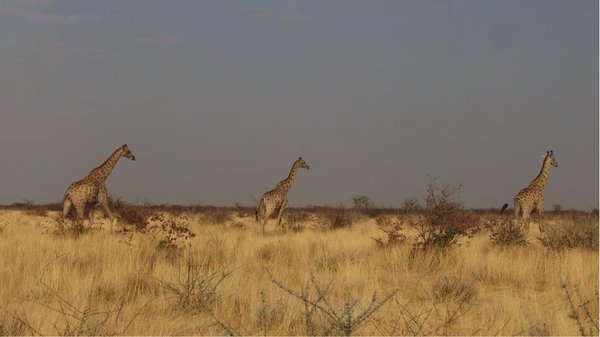 Read this article in French
Read this article in French- Share this article
- Subscribe to our newsletter
Browsing herbivores increase savannah resilience to droughts
Savannahs are woodland-grassland ecosystems with low water availability. This makes them very susceptible to extreme climatic events. However, savannahs provide a number of important ecosystem services.
The highly variable rainfall and low water availability in savannahs mean that these areas are often unsuitable for agricultural use. However, commercial livestock farming is an important source of income for agriculture in southern Africa. “Extensive livestock farming is somewhat flexible,” says Katja Irob, a biologist at Freie Universität Berlin/Germany. “It allows farmers to adapt to challenging, ever-changing environmental conditions and means that rangeland is the more economically secure option in years of drought. However, we need to find a balance between economic sustainability and the ecological capacity of rangeland to recover.”
The results of the study conducted by Katja Irob and a team at the Theoretical Ecology Working Group at Freie Universität Berlin also made it clear that savannahs dominated by cattle ranching have an overabundance of shrubs and fewer grasses. This is because cows prefer to eat grasses and other herbaceous plants, giving shrubs a competitive advantage and thus a greater chance to grow.
However, a diminished grass layer increases the risk of soil erosion, leading to lower productivity and alterations in the area’s nutrient cycle and water balance. New studies have already pointed out that reducing grazing intensity and introducing wild animals improves the resilience of an ecosystem and thus the way the land is used.
Irob and her team took this information to formulate their own hypothesis: that a lower number of grazing animals (e.g. cattle, goats, sheep), and a higher number of browsers (e.g. kudus, springboks, giraffes), which often consist of a diverse community of herbivores with a higher number of shrub-eating herbivores, lead to a more balanced ecosystem and thus increase the resistance of savannahs to droughts.
Native herbivores could yield higher financial returns
Moreover, native wild animals could ultimately provide higher financial returns. This is because they are more adapted to unfavourable climatic conditions than cattle. Additionally, wild animals would offer an alternative to the production of red meat, and their uniqueness would also allow for greater use in the tourism industry.
In the article “Savanna Resilience to Droughts Increases with Proportion of Browsing Wild Herbivores and Plant Functional Diversity”, Irob explains that she and her team made use of the ecohydrological savannah model EcoHyD to determine whether the resilience of a savannah rangeland to prolonged droughts can be enhanced by the choice of rangeland use type (grazer-dominated, mixed feeders or browser-dominated) and animal density. This work was carried out under the leadership of Professor Britta Tietjen, head of the Theoretical Ecology Working Group at Freie Universität Berlin.
“Generally, we saw that the higher the number of grazing animals, the lower the resistance of the savannah to climatic events, like drought. Above all, we discovered that the functional diversification of herbivores and plants acted as a kind of insurance against droughts, leading to greater resistance and recovery of perennial grasses. This higher level of resistance was made possible by higher numbers of shrub-eating herbivores in particular,” emphasised Irob.
Diversifying the number of herbivores within a savannah system was shown to reestablish complexity within the food webs in place there. This meant that the area was better able to self-regulate, thus reducing the need for additional management interventions.
The model simulations by the researchers also showed that savannah systems are more resistant to drought when three conditions are met, namely:
- when dense perennial grass cover is maintained, protecting the topsoil from heat-induced water loss and erosion,
- when the grazing pressure is adjusted to the productivity of the system, and
- when the herbivore community includes browsers.
(FU Berlin/wi)
Reference:
Irob, K., Blaum, N., Weiss-Aparicio, A., Hauptfleisch, M., Hering, R., Uiseb, K., & Tietjen, B. (2023). Savanna resilience to droughts increases with the proportion of browsing wild herbivores and plant functional diversity. Journal of Applied Ecology, 00, 1– 12. https://doi.org/10.1111/1365-2664.14351
More information:





Add a comment
Comments :
I am surprised that the authors did not refer at all to (indigenous breeds of) domesticated browsers, which are – like native wildlife – well adapted to dry conditions.
Many people seem to think that pastoralists and their livestock should be evicted from savanna areas in the name of nature conservation – and such people “feed" on such articles suggesting that fewer domesticated animals and more wildlife would be better for the savannah – even though pastoralists’ camels and goats (as browsers) could serve the same function as kudus and giraffes.
I suggest that you include an article about management of indigenous domesticated and wild animals by pastoralists, rather than appearing to argue in favour of wildlife to conserve nature, produce red meat and attract tourists.